Boro Bari: The Big House
Forty-odd years ago, I entered the “Boro Bari” through a nondescript door and stepped into a cool and dark hallway while the smell of the Calcutta summer made my senses dance.
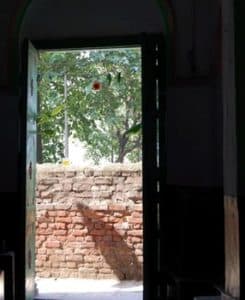
Boro Bari – literally, the Big House – is the ancestral home of my in-laws in Kumartuli, a northern suburb of the city.1
It was built by my husband’s great-great-grandfather’s brother, Ganga Prasad Sen. By all accounts, Ganga Prasad and his brother Durga Prasad were accomplished Ayurvedic doctors, “Kaviraj” as they say in Bengali. As the older sibling, Ganga Prasad was the more renowned of the duo. They counted among their patients the grand pooh-bahs of Calcutta and Lucknow who paid them in gold coins. Intensely devout, they were blessed to have treated the revered Sri Ramakrishna Paramhansa who was diagnosed with throat cancer prior to his passing.2
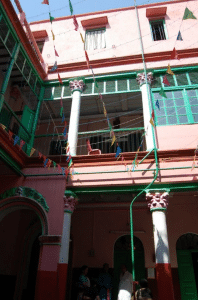
On the first visit, I felt myself dwarfed in the courtyard of this vibrant and happy home, surrounded by a three-level house with long verandas. The shutters were green, the house was a bright orange-yellow then, now pink. To this day, visiting the Boro Bari instantly transports me to the grand homes of Calcutta from the early 1900s.
Boro Bari is an eclectic mix of Indian and European. The accouterments in the house range from a hookah to highly stylized European chandeliers, beveled mirrors and statues. The structure of the house is suited to the quintessential Indian joint family with parents, siblings and adult children living in semi-autonomous and dependent ways. With individual living quarters and a shared kitchen, the house offers plenty of room for dozens of inhabitants. In the early days, the women in the family spent their days managing the household while the men went about their academic and professional careers. Whenever I am in the house, I feel energized by the rhythms of the past ringing through the rooms.
The house predates electricity. Large cloth fans once hung on gigantic hooks and were operated by ropes. The fans are gone, the people who operated them are long dead, yet the hooks hold fast reminding us of the ingenuity of a simpler era.
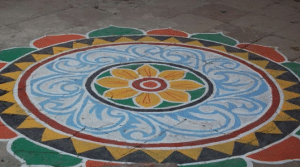
In the courtyard, a large “alpona”, a decorative hand-painted design, welcomes guests and gods alike. In the old days, alpona was made from ground rice flour, then colored powders, and now with paint. One of the rooms is called the “Naach Ghar”, the dance room. This is where the men were entertained by dancers while the women watched from above through tiny windows with slats. A part of me wishes to go back in time to fling open the windows and watch without hindrance.
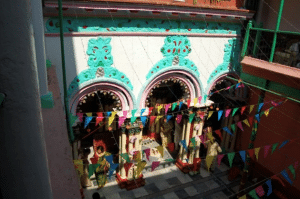
The narrow alley that leads to this house with the grand courtyard ends at the Hooghly river, another name for the Ganga. One side of Boro Bari sits on the river bank, separated from the water by a train line carrying millions of modern-day commuters from the suburbs into the bustling city. The house is a pricey real estate for sure, probably unaffordable now.
Ganga Prasad was a man of tremendous foresight.
He left the house to his descendants with one stipulation. They are required to celebrate Goddess Durga’s festival every autumn without fail. As long as this happens, the children of his children and their descendants can continue living in this property; otherwise they will have to move out. This brilliant strategy to preserve our heritage is nothing short of spectacular.
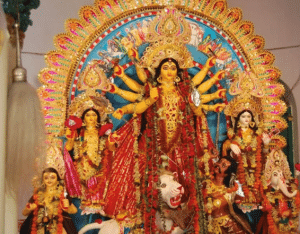
Each year, between mid-September and end of October, the idol of Goddess Durga arrives in the courtyard with pomp and circumstance. The goddess is an imposing warrior. With ten hands each wielding a weapon, she stands tall, glowing with a serene smile, pleased that her children – two boys and two girls-helped her defeat the demon or “asura,” who was terrorizing the good people of the earth. For five days, her victory over evil is celebrated with morning and evening prayers.3
Family, friends, and neighbors gather at the sound of the conch shell, offer flowers and food to the deity, sing her praise, and pray for peace and joy. During this time, representatives from different branches of the family come together for celebrations and meals. We sit at rows of tables, eating on banana leaves with our hands. To our delight, the traditional menu has remained unchanged by the winds of time.
Several years ago, my husband and I visited Boro Bari during Durga Puja. We ate, reveled, rested and enjoyed time with the extended family, thankful to Ganga Prasad for allowing generations to enjoy this beautiful house. For our sake and our children’s sake, we hope that Durga will never stop visiting the Boro Bari and that she will continue to bless the house with affection. In the meantime, I count my blessings for landing in this family by chance.
September 2024
Rumy Sen is a technologist, entrepreneur and author who writes to chronicle her world for her children and to make sense of what is coming in the context of what is in the rear-view mirror.
Rumy lives in Virginia, USA.
Footnotes
- Literally meaning potters’ quarters, this is the place where images of gods and goddesses are sculpted
- The 19th century seer from Bengal who died in 1886
- There is a pairing of two myths, one of Durga coming home to her parents with the four children and the other of the strong Goddess and slayer of the evil demon
